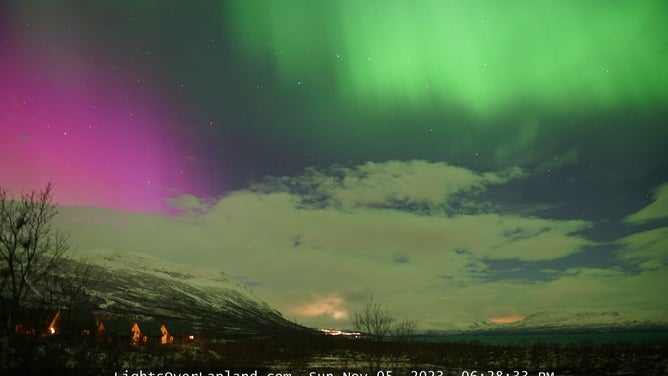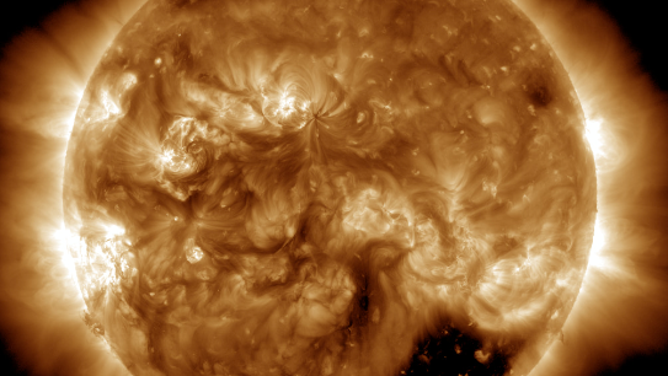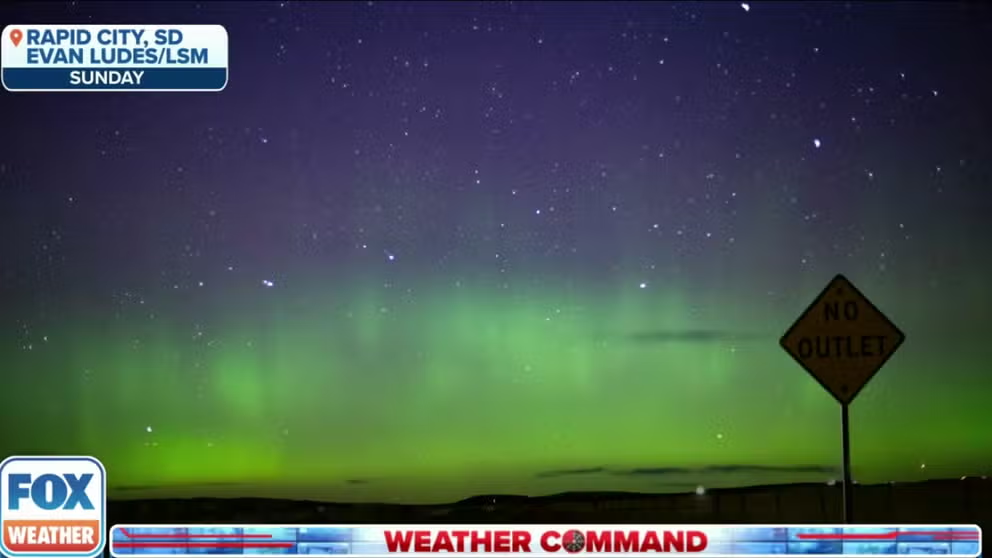More Northern Lights possible as Earth gets 'whacked' by back-to-back geomagnetic storms
An ongoing geomagnetic storm brought faint aurora lights as far south as Texas. As plasma swings back around, another round of strong auroras are possible later this week.
Northern lights put on incredible display over northern US
A geomagnetic storm created an incredible view of the aurora lights in Wyoming, North Dakota, Maine and as far south as North Texas.
A series of eruptions from the Sun sent solar wind and plasma blasting toward Earth, causing NOAA's Space Weather Prediction Center to issue back-to-back geomagnetic storm watches this week and exciting skygazers with Northern Lights displays.
The first strong geomagnetic storm this week created aurora lights seen as far south as north Texas and North Carolina. A G3-level storm set skies on fire with colorful aurora borealis in places near the Arctic Circle, like Alaska and Sweden.
NOAA's SWPC issues Geomagnetic Storm alerts to warn of potential interference with communication systems and spacecraft operations. During significant solar storms, widespread power outages are possible, and communication systems are subject to failure.

The Northern Lights seen above Abisko National Park in Sweden on Nov 6, 2023. (Image: LightsOverLapland.com)
Another round of space weather from a coronal hole high-speed stream, or CH HSS, is set to arrive on Wednesday into Friday. NOAA's SWPC issued a moderate G2 Geomagnetic Storm Watch for Tuesday as fast solar wind associated with the CH HSS and lingering impacts from a coronal mass ejection (CME) event over the weekend.
Impacts from these Sun phenomena are forecast to continue through the end of the week.
What caused this week's Northern Lights activity?
Cooperative Institute for Research In Environmental Sciences (CIRES) scientist Mark Miesch, the solar cycle lead at SWPC, provides computer models for CMES like those that caused this week's geomagnetic storms.
NOAA and NASA satellites observing the Sun let the SWPC know when a solar event has happened, and then space weather forecasters work to determine when those impacts will arrive in Earth's atmosphere.
7 THINGS TO KNOW ABOUT THE NORTHERN LIGHTS
"What causes the biggest geomagnetic storms are these coronal mass ejections, these clouds of plasma that come from the Sun," Mark Miesch, solar cycle lead at SWPC. "For the one this past weekend, there were three; there was a series of three beginning with Halloween."
While CMES take between 1 and 3 days to reach Earth's atmosphere, coronal holes can have longer-lasting impacts. These solar features look like dark areas on the Sun because they don't have plasma.

A solar coronal hole in April 2014 seen in the southern hemisphere of the Sun. (Image: NASA SDO)
The plasma travels out into space, streaming along the magnetic field lines of the Sun.
"If the HSS runs into the slower moving solar wind, it creates a shockwave, and that shockwave can wash over the Earth and cause a pretty big magnetic storm too," he continued.
The Sun spins every 27 days, and if Earth gets hit by a high-speed stream, there's a chance it could strike again in 27 days, which is what is expected to happen this week.
"It's going to rotate around in the next few days. And we think we're going to get whacked by a big high-speed stream," Miesch said.
Solar cycle ramping up
The geomagnetic storms and associated aurora activity are because the Sun's activity is increasing as it approaches the Solar Maximum during an 11-year solar cycle.
NOAA's Space Weather Prediction Center recently released an update forecasting Solar Maximum to happen sooner than the initial forecast issued by an international panel of space weather experts in 2019 when the Solar Cycle 25 began.
THE DAY THE NORTHERN LIGHTS COVERED THE PLANET: HISTORY OF EARTH'S GREATEST SOLAR STORMS
"It became clear that by a few years into the cycle that, the 2019 prediction was probably going to be too low," Miesch said.
The latest SWPC forecast for Solar Cycle 25 moves up the solar maximum to January- October 2024. The previous prediction by the Solar Cycle 25 panel placed the solar maximum sometime in July 2025.

The Northern Lights dancing above the Riverton, Wyoming National Weather Service office on Sunday, Nov. 5, 2023. (Image: NWS Riverton)
The Space Weather Prediction Center also noted the earlier peak will be good for the upcoming total solar eclipse in April 2024, happening closer to the Solar Maximum.
"The Sun may put on a good show, with a particularly impressive corona – the extended outer atmosphere of the Sun that is only visible during an eclipse," according to the SWPC.
Counting sunspots
Miesch explains counting sunspots is one of the baselines used to predict the activity during a solar cycle because it's one of the oldest measurements we have.
Astronomers in the 1800s realized sunspots were part of an 11-year cycle.
"Nothing has the 400-year history of sunspot," Miesch said. "You can even trace it further back from that that people, even before the invention of the telescope, people saw sunspots with the naked eye."
You can count the sunspots right now thanks to NASA's Solar and Heliospheric Observatory.

The Sun as seen by NASA's SOHO on Nov. 7, 2023.
The amount of sunspots during the current cycle has already surpassed the previous Solar Cycle 24. The SWPC is now issuing updated Solar Cycle forecasts each month as new sunspot data becomes available.
The previous forecast estimated peak solar activity with 115 sunspots. With the new forecast, the SWPC predicts about 152 sunspots during solar maximum.
Increasing sunspots and CMEs also mean more opportunities for people to witness the Northern Lights farther south than during less active times in the solar cycle.
When will activity peak?
Solar Maximum isn't a one-day or even a week-long event. It's ongoing and can even take years.
"The peak is not sharp. It's not like it goes way up and then comes back down. It's kind of flat," Miesch said.
Under the current prediction, Miesch said the next two years will see the most geomagnetic storms and aurora than we've seen in 20 years, or since Solar Cycle 23, which peaked in 2001.
Miesch said even though Solar Cycle 25 is stronger than originally predicted, it will still likely be below average. However, that doesn't mean it's less important because space weather can impact the technology we use in our daily lives, like GPS.
"The Sun is about the same, but society keeps changing," Miesch said.
During the last time solar activity was this high in 2001, the world was a different place.
"iPhones didn't exist and, now GPS, the satellites we've become more and more dependent on GPS, and it's even in places where you would not expect," Miesch said. "If a big solar storm took out GPS satellites, that would be a big deal."
